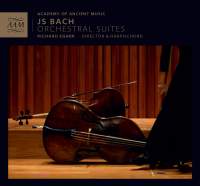Texte paru dans: / Appeared in: |
|
| "... warmly recommended." |
Outil de traduction (Très approximatif) |
|
|
|
|
Reviewer: James
A. Altena How does this OPPP performance come off in terms of sonority and balances? Overall, quite well. My own preference is for a slightly larger ensemble, and sometimes in the Third and Fourth suites in particular I thought that more strings would be welcome to offset the greater weight of the trumpets and timpani. However, since many Bach musicologists now believe that the surviving autograph parts (by Bach, his son C. P. E. Bach, and Bach’s pupil Johann Ludwig Krebs) are strong evidence of OPPP scoring, that is a matter of subjective taste. I will note that, having played this set on several different systems, ranging from a portable CD player to a full-size five-speaker stereo system, the performances come across significantly better on the latter; on smaller systems the solo string parts can sound a bit anemic. As is the wont of the AAM, the timbre of the string players is on the more astringent side, which especially displeases those who are not favorably inclined toward HIP renditions to begin with; but while I myself also prefer a warmer string tone, there is nothing here that sets my teeth on edge. The recorded sound is ideally crisp and clear. The one disadvantage to this set is that it sells for the price of two full-price CDs (about $30 on Amazon) for just slightly over 90 minutes of music. By contrast, the aforementioned competing sets by Hogwood and Goodman (the latter being my favorite version), among several others, offer generous fillers and are available as mid-price sets. If by any chance you are just starting out on acquiring an HIP performance of the suites for your collection, I would suggest you choose one of those instead, as this new set is something of a luxury item. However, if you have the disposable income and the inclination to try an OPPP approach to these works, then by all means do buy this set; warmly recommended. | |
|
|
|
|
Cliquez l'un ou l'autre
bouton pour découvrir bien d'autres critiques de CD |
|




